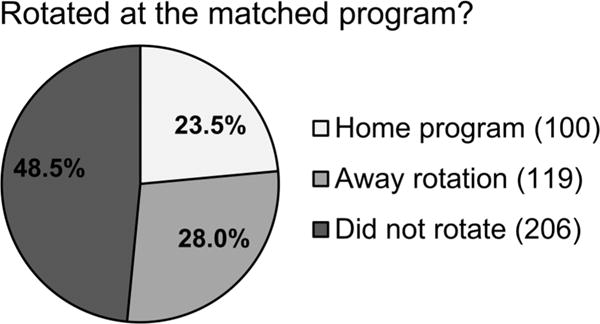Radiation oncology residency applicants invest considerable effort to improve their chances of a successful match. Participation in elective rotations is seen not only as a method for gaining valuable information about potential programs, but also as a way of improving their probability of matching by “auditioning” with a program. To date, there is no data documenting the value of away rotations with regard to matching. We hypothesized that participation in an elective rotation is associated with the applicants eventually matching into that program.
We analyzed an open-access, self-reported database in “RadOnc Interview Spreadsheet” for the 2015, 2016, and 2017 radiation oncology match, accessed in July 10, 2017 – available in Student Doctor Network (SDN; https://forums.studentdoctor.net/threads/2016-2017-radonc-interview-spreadsheet.1222027/), an online forum for medical students. A limitation of this analysis is that applicants input data which should be accepted with caution. We assumed the good faith of radiation oncology applicants helping fellow applicants. This analysis was deemed not-human subjects research by the University Health Sciences Institutional Review Board.
After the residency match for three respective years, 531 students revealed their matched programs, their home institution, and whether they did an away elective at the matched program. Students whose home institution was not in the mainland U.S. (n=4) were excluded, leaving a total of 527 matched students (181, 173, and 173 in 2015, 2016, and 2017, respectively) representing 93% (527/566) of residency spots (1–3). The most common number of radiation oncology elective rotations (including one in their home institution) completed was 3 (range: 0–5; mean: 2.8, SD = 0.8). Just over 50% of matched applicants rotated at the program they matched into (24% at home institution, 28% as away elective, Figure 1).
Figure 1.

Applicants’ elective rotation participation relative to their matched programs
Applicants are often told that they have a better chance of matching into a program at which they have done an away rotation. These data provide an interesting view of the importance of elective rotations. More than half of matched applicants did an elective rotation at the program they matched into suggesting that these rotations help some applicants secure their residency positions. This also means that nearly half of applicants matched to a program where they did not perform a rotation.
One potential interpretation of these data is that applicants should consider focusing their 4th year elective time on rotations that will provide them valuable medical experiences outside of radiation oncology. Applicants often feel significant pressure to rotate at multiple programs with the goal of improving their chances for a successful match. The consequence of these choices is that applicants can spend close to 25% of their medical school’s elective clinical rotations in radiation oncology prior to spending 3–4 years pursuing dedicated training in the field. This time has clear trade-offs – time spent in radiation oncology is time not spent in other fields. There is significant value to be gained by spending time in other specialties. These opportunities could be highlighted by mentors encouraging an applicant who is applying for a 3rd or 4th elective rotation to consider an alternative. This finding does not necessarily indicate that multiple rotations are unimportant. Students and programs can gain valuable insights about each other during the rotation. It can be valuable to gain an understanding of which programs “fit” a given applicant during a four-week rotation rather than suffer through a poor match for four years.
Like many aspects of cancer care, the decision to pursue an elective rotation should be individualized. Students are encouraged to recall that an important goal of medical school is to be a well-rounded physician, not necessarily a radiation oncologist. There is time enough for that during residency.
Acknowledgments
Sources of support: None
Meeting presentation: None
Footnotes
Publisher's Disclaimer: This is a PDF file of an unedited manuscript that has been accepted for publication. As a service to our customers we are providing this early version of the manuscript. The manuscript will undergo copyediting, typesetting, and review of the resulting proof before it is published in its final citable form. Please note that during the production process errors may be discovered which could affect the content, and all legal disclaimers that apply to the journal pertain.
CONFLICT OF INTEREST STATEMENT
S.J.: Applicant in the 2017–2018 radiation oncology residency match
K.A.B.: Radiation Oncology Program Director at University of Wisconsin; royalties as contributing author to UpToDate
R.J.K.: Sponsored research agreements with Threshold Pharmaceuticals and Peloton.
Therapeutics provide research funding unrelated to this work.
The remaining authors have nothing to declare
References
- 1.NRMP. Results and Data: 2017 Main Residency Match. 2017 http://www.nrmp.org/wp-content/uploads/2017/06/Main-Match-Results-and-Data-2017.pdf. Accessed July 2017.
- 2.NRMP. Results and Data: 2016 Main Residency Match. 2016 http://www.nrmp.org/wp-content/uploads/2016/04/Main-Match-Results-and-Data-2016.pdf. Accessed July 2017.
- 3.NRMP. Results and Data: 2015 Main Residency Match. 2015 http://www.nrmp.org/wp-content/uploads/2015/05/Main-Match-Results-and-Data-2015_final.pdf. Accessed July 2017.


